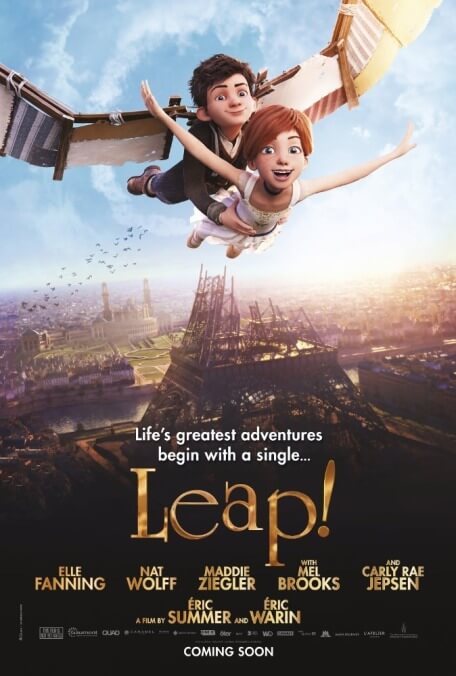The animated import Leap! can’t quite cut to the feeling

If nothing else, the animated movie Leap! can be credited with hastening the release of a great song. Carly Rae Jepsen’s buoyant “Cut To The Feeling” escaped the singer’s seemingly endless trove of Emotion outtakes to score a spot over the movie’s credits (along with a second, less electrifying CRJ song) and an official commercial release earlier this year. “Cut To The Feeling” is conspicuously absent from the film’s soundtrack album, and while that feels like a potential rip-off for a movie that features Jepsen in a prominent voice-over role, it also makes sense. As it happens, “Feeling” is not all that appropriate to a cartoon about a ragamuffin tween orphan who wants to become a ballerina in 19th century Paris. There is one throwaway lyric (“I want to dance on the roof”) that fits the movie’s story, in that its heroine both wants to dance and goes up on a roof a couple of times. But most of the song describes a romantic heedlessness (“I wanna wake up with you all in tangles”) that sounds pretty inappropriate for barely adolescent Felicie (Elle Fanning), even or especially in relation to her needy best friend and fellow orphan Victor (Nat Wolff).
The idea of using contemporary pop songs to tell Felicie’s story, though, isn’t a bad one, and the movie does seize on it, cueing up Demi Lovato’s “Confident” alongside some lesser-known songs that may not be native to 19th century France. But it also fails to strike any sparks with its anachronisms, even though it seems to be set only shortly before the 1900 of Baz Luhrmann’s delirious Moulin Rouge!. (The movie’s fudging of Eiffel Tower and Statue Of Liberty construction as concurrent events makes it tricky to figure out which specific decade in the late 19th century it’s utilizing.) The needle drops, the pop choruses explode, and the movie’s ballet training montages just lie there, disconnected from the music’s shiny insistence. Rather than inspiring some kind of connection between disparate eras, Leap! uses pop music as a quick fix for kids who might be bored by ballet or orphans.
Older kids and even parents might yet find relief in Leap! simply because it’s not another cartoon about jabbering animals or ovoids. But computer-animating humans is a trickier task, and while the animation here is reasonably polished for a lower-tier cartoon, it struggles with how to best depict dancing, an action not always well-suited to this medium. Leap! puts a lot of stock in ballet dancers’ ability to defy gravity, but in animation anything can defy gravity—as shown in a subplot about Victor’s inventions, most of which are variations on rickety wings to help humans flout nature’s will a few decades ahead of schedule. When a movie stages a climactic air battle featuring its tween heroes, it undercuts suspense over whether Felicie will complete a ballet jump that would, in live-action form, probably shatter her ankle.
The core of Leap! involves Felicie (described as having “the energy of a bullet,” but “the likeness of a depressed elephant”) scamming her way into a prestigious dance school in Paris and competing for a spot in its performance of The Nutcracker. (For a prestigious school, the curriculum seems to depend a lot on unforgiving reality-show-style eliminations.) Getting her there, however, takes a fussy, overelaborate amount of plot and a swollen cast of characters—too many for any personalities to register even on a cartoon level. Even the important characters have the approximate depth of bit parts; several abruptly pivot from antagonism to abiding sympathy, while another one turns full-on murderous before the movie ends.
Perhaps something has been lost in the movie’s sort-of-translation. Leap! has already been released in other countries in both French and English versions, but the U.S.-specific incarnation has been subjected to some strange backstage shuffling. (Why should animation be exempt from Weinstein Company meddling?) Mel Brooks and Kate McKinnon have been added—Brooks with many lines obviously squeezed in as non-animated ADR, and McKinnon as a bizarre form of pick-up, taking over vocal duties for three different motherly characters—while one young American actor (Dane DeHaan) has been replaced with another (Wolff).
The switch-ups can’t conceal the movie’s mismatches, with Elle Fanning (sounding like a slightly hoarse Alicia Silverstone) cast as a character many years her junior, while Jepsen, sounding as chirpily Canadian as ever, incongruously gives voice to a melancholy, wizened mentor. It doesn’t have to be a problem that Jepsen doesn’t sound like a “real” 19th century Parisian or that Fanning and Wolff don’t sound like scrappy orphans. But in this case, the voices emphasize the plastic sheen that smothers any sense of human emotion. “Cut To The Feeling” showing up for the end credits only makes matters worse. The song is synthetic pop that turns to ebullient bliss. Leap! is just synthetic.